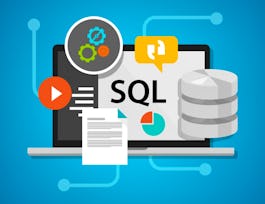As data collection has increased exponentially, so has the need for people skilled at using and interacting with data; to be able to think critically, and provide insights to make better decisions and optimize their businesses. This is a data scientist, “part mathematician, part computer scientist, and part trend spotter” (SAS Institute, Inc.). According to Glassdoor, being a data scientist is the best job in America; with a median base salary of $110,000 and thousands of job openings at a time. The skills necessary to be a good data scientist include being able to retrieve and work with data, and to do that you need to be well versed in SQL, the standard language for communicating with database systems.



SQL for Data Science
This course is part of Learn SQL Basics for Data Science Specialization

Instructor: Sadie St. Lawrence
Sponsored by RIA PAYMENT INSTITUTION
639,361 already enrolled
(16,594 reviews)
What you'll learn
Identify a subset of data needed from a column or set of columns and write a SQL query to limit to those results.
Use SQL commands to filter, sort, and summarize data.
Create an analysis table from multiple queries using the UNION operator.
Manipulate strings, dates, & numeric data using functions to integrate data from different sources into fields with the correct format for analysis.
Details to know

Add to your LinkedIn profile
14 assignments
See how employees at top companies are mastering in-demand skills

Build your subject-matter expertise
- Learn new concepts from industry experts
- Gain a foundational understanding of a subject or tool
- Develop job-relevant skills with hands-on projects
- Earn a shareable career certificate


Earn a career certificate
Add this credential to your LinkedIn profile, resume, or CV
Share it on social media and in your performance review

There are 4 modules in this course
In this module, you will be able to define SQL and discuss how SQL differs from other computer languages. You will be able to compare and contrast the roles of a database administrator and a data scientist, and explain the differences between one-to-one, one-to-many, and many-to-many relationships with databases. You will be able to use the SELECT statement and talk about some basic syntax rules. You will be able to add comments in your code and synthesize its importance.
What's included
11 videos3 readings4 assignments2 discussion prompts
In this module, you will be able to use several more new clauses and operators including WHERE, BETWEEN, IN, OR, NOT, LIKE, ORDER BY, and GROUP BY. You will be able to use the wildcard function to search for more specific or parts of records, including their advantages and disadvantages, and how best to use them. You will be able to discuss how to use basic math operators, as well as aggregate functions like AVERAGE, COUNT, MAX, MIN, and others to begin analyzing our data.
What's included
9 videos1 reading3 assignments
In this module, you will be able to discuss subqueries, including their advantages and disadvantages, and when to use them. You will be able to recall the concept of a key field and discuss how these help us link data together with JOINs. You will be able to identify and define several types of JOINs, including the Cartesian join, an inner join, left and right joins, full outer joins, and a self join. You will be able to use aliases and pre-qualifiers to make your SQL code cleaner and efficient.
What's included
10 videos2 readings3 assignments1 discussion prompt
In this module, you will be able to discuss how to modify strings by concatenating, trimming, changing the case, and using the substring function. You will be able to discuss the date and time strings specifically. You will be able to use case statements and finish this module by discussing data governance and profiling. You will also be able to apply fundamental principles when using SQL for data science. You'll be able to use tips and tricks to apply SQL in a data science context.
What's included
11 videos3 readings4 assignments1 discussion prompt
Instructor

Offered by
Why people choose Coursera for their career




Learner reviews
16,594 reviews
- 5 stars
73.67%
- 4 stars
19.92%
- 3 stars
3.48%
- 2 stars
1.43%
- 1 star
1.49%
Showing 3 of 16594
Reviewed on May 24, 2023
It waas one of the best courses I attended in Coursera. I learned a lot in a short period of time, and it has great hands-on exercises. Thank you very much for preparing a useful course like this!
Reviewed on Oct 22, 2020
Honestly it's not obvious why it is called sql for DATA SCIENCE.
Reviewed on Apr 5, 2020
This course has really helped with optimizing queries that I work with everyday, enhancing my understanding of RDBMS, joins, analyzing and structuring exactly what you need and yielding those results.
Recommended if you're interested in Data Science

Open new doors with Coursera Plus
Unlimited access to 10,000+ world-class courses, hands-on projects, and job-ready certificate programs - all included in your subscription
Advance your career with an online degree
Earn a degree from world-class universities - 100% online
Join over 3,400 global companies that choose Coursera for Business
Upskill your employees to excel in the digital economy





